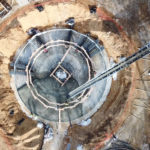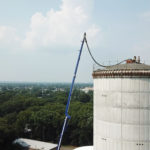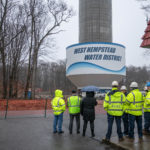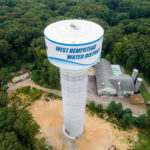H2M is honored to have received a Project of the Year award from the New York State section of the American Water Works Association (NYAWWA). The Project of the Year award was established to promote excellence in the management and administration in the water industry by recognizing the alliance between the managing agency, consultant, engineer, and contractor that by working together complete potable water projects.
In the “Groundwater Elevated Storage” category, H2M’s Replacement of Birch Street Elevated Storage Tank project with West Hempstead Water District won. Read below for a project description and photos.
West Hempstead Water District’s (District) Birch Street facility was home to their 80 year old, 750,000 gallon water tank. As the existing tank reached the end of its useful life, the Board of Commissioners and Superintendent knew that the new design had to be carefully developed; and continue to be a symbol of the West Hempstead Community while subtly serving as the trusted landmark so many have come to rely on.
The District’s engineer, H2M architects + engineers (H2M) evaluated capital and maintenance costs over the anticipated life of the tank and determined that a composite elevated storage tank would be the most cost effective solution for the District, while also keeping with the visual continuity of the community skyline. This would be the first of its kind on Long Island, and the start of an exciting adventure for both the District and H2M, who have a longstanding relationship.
A composite elevated storage tank combines concrete and steel, creating a new and innovative option for tank construction. The composite tank utilizes a concrete pedestal in lieu of steel and the benefit is two-fold; concrete is a more sustainable material for construction on Long Island while reducing the amount of surface area of steel that would eventually require rehabilitation and coatings throughout the life of the tank.
Economically, this style tank had the most optimal life cycle costs, as the composite style tank has the least amount of steel surface; therefore, lowering maintenance costs. Sustainable considerations were taken in terms of the materials used. The locally sourced concrete is a more sustainable material for construction on Long Island, especially in terms of corrosion-resilience with regard to exposure from salt-laden wind coming off the Atlantic Ocean.
The construction methods utilized for this style tank were innovative, providing a safer work environment and high quality of workmanship. With the exception of the roof, the entire steel bowl was welded together, blasted, and painted on the ground; then hoisted up to be placed at the top of the concrete pedestal. Traditional steel tank construction occurs at a high elevation, where wind (especially on Long Island) poses critical safety concerns. Due to Long Island’s close proximity to the ocean and relatively flat landscape, 20 mile per hour sustained winds (at tank elevation) are the norm, even if the winds on the ground seem calm. Therefore, constructing at a high elevation while using swing scaffolding, spider baskets, and tie-offs can be risky. Since the tank bowl was constructed on the ground, at the base of the pedestal, contractors were able to use scaffolding towers for more stable footing, increasing their concentration when performing tasks. Prioritizing worker protection during welding, blasting, and painting resulted in a higher quality product.
A challenge during this project was maintaining the existing operations of the District during the construction of the new tank. Tank construction was expected to take place during both the 2018 and 2019 pumping seasons, which would have put an undue burden on the District to maintain normal system pressure and meet potential fire-flow demand during peak summer water demands. H2M needed to find a location that fit the District’s existing infrastructure, and provided enough property for staging and construction of the tank. The District had a large enough parcel of land within its main plant to allow for the construction of the tank, with no water service interruptions or periods of low pressure. The construction process was closely monitored by H2M, and as challenges arose, the District was able to truly understand the implications of the design/construction decisions before them.
On January 8th, 2019, the steel bowl was hoisted up to the top of the pedestal displaying the distinctive logo designed by Board Member John Sparacio. The hoist occurred seamlessly and quicker than originally anticipated. It was also live streamed by H2M for the residents of the District, a conclusion to the project outreach that H2M executed on behalf of the District.
The District took an innovative approach to informing the public of the new tank, as they felt it was a necessity to inform their constituents about what was going on. Their goal was to educate the residents on all the benefits that would come from the construction of this new tank, and wanted their residents to understand that the random concrete pedestal they saw while driving to work wasn’t going to always appear so random.
H2M ‘s marketing team spoke with the Board Members and Superintendent to make sure that the story of this new tank was not only delivered to the community, but delivered properly; a general communication that most water districts wouldn’t embrace. The campaign featured interviews with Board Members, time lapse videos, videos explaining the importance of the new tank, and general communication that should be had with residents who will one day look up and see the rest of the water tank in their skyline.
The construction of the new composite elevated storage tank at the Birch Street Facility was designed with the future of the District and the water industry in mind. The new tank, which is now capable of storing 1,000,000 gallons received operational authorization from the local Department of Health in September of 2019, and will serve the community well into the next century, all the while providing lower maintenance costs and allowing critical capital funds to be re-invested in the District for other needs like containment removal.
Click on the photos below to expand.








